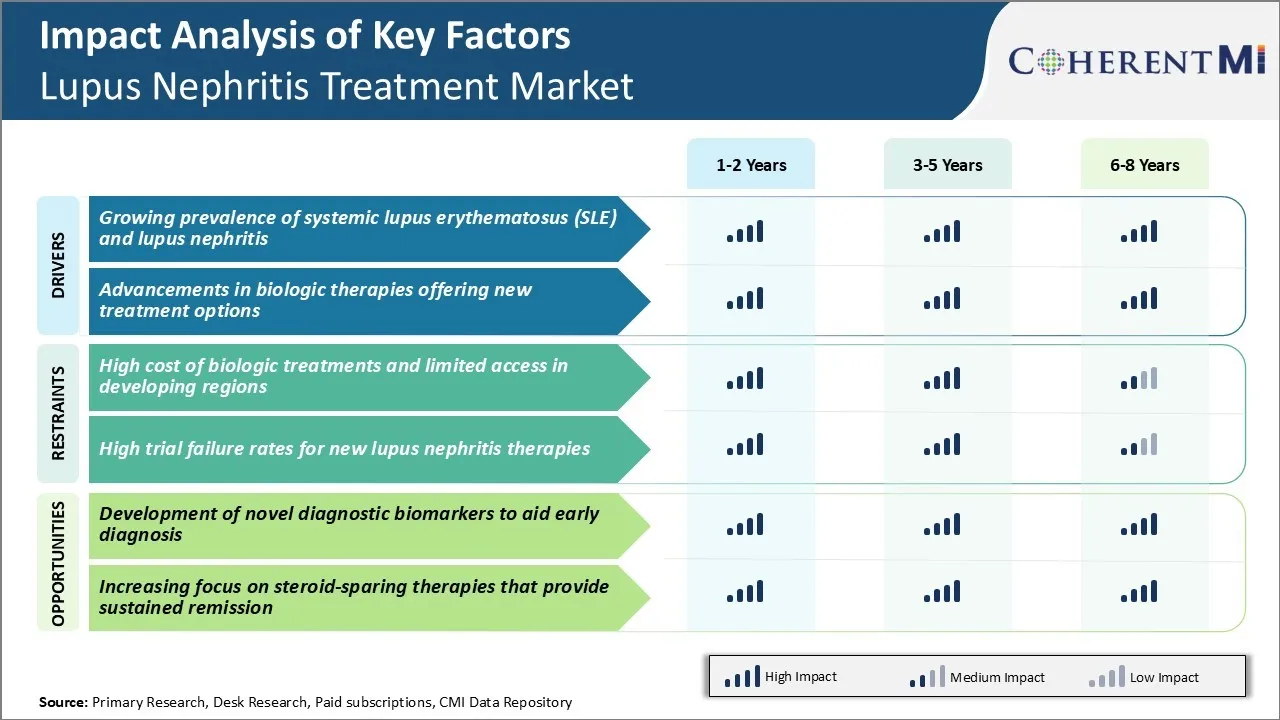Lupus Nephritis Treatment Market Trends
Market Driver - Growing Prevalence of Systemic Lupus Erythematosus (SLE) and Lupus Nephritis
As per estimates, up to 60% of patients with SLE will eventually develop lupus nephritis at some point in their lifetime making it a major public health concern. The exact causes are yet unknown but genetics, environment and hormonal factors all play a role.
It predominantly affects women of childbearing age with estimates suggesting a female to male ratio of 8-10:1. In the United States alone, it is estimated that around 322,000 new cases of SLE are diagnosed annually with rates especially high among Hispanic, African and Asian populations.
As the underlying SLE condition remains uncontrolled and untreated for long periods, it often manifests into inflammation of kidneys known as lupus nephritis. Uncontrolled nephritis leads to permanent kidney damage over time and even failure requiring dialysis or transplant.
Recent studies suggest up to 50% of SLE patients eventually progress to some form of nephritis within 10 years of diagnosis. With rising SLE prevalence, absolute number of patients developing lupus nephritis has also increased substantially presenting a massive future patient pool. Overall, growing prevalence of the disease and its severe renal complications indicates a growing target population seeking effective treatment and management options for lupus nephritis.
Market Driver - Advancements in Biologic Therapies Offering New Treatment Options
Traditionally, therapy for lupus nephritis has involved use of broad acting immunosuppressants like corticosteroids and azathioprine to bring inflammation under control. However, such non-specific drugs come with a lot of side effects if used long term. In recent years, improved understanding of lupus pathology has enabled development of novel targeted biologic therapies which selectively block specific cytokines, cells or pathways implicated in disease activity.
Notable among the new treatment options are B cell depleting therapies like belimumab which binds to B-lymphocyte stimulator (BLyS) to reduce B cell proliferation. Belimumab was the first biologic approved by FDA in 2011 specifically for treatment of SLE. Several other BLyS inhibitors are in pipeline.
Moreover, several advanced therapies utilizing stem cells, nanocarriers and gene therapies are under investigation which may potentially provide complete remission if proven safe and effective. Growing understanding of disease biology is enabling tailored targeting of specific pathological mechanisms underlying SLE and lupus nephritis.
This recent development of selective biologic response modifiers provides viable treatment alternatives with improved efficacy and safety profiles. The availability of novel targeted therapies is hence expected to further expand treatment options for lupus nephritis patients not adequately controlled on standard of care regimens.

Market Challenge - High Cost of Biologic Treatments and Limited Access in Developing Regions
The high cost of biologic treatments for lupus nephritis poses a notable challenge for the lupus nephritis treatment market growth potential. Biologics such as belimumab have revolutionized lupus treatment but come with a steep price tag. A year of treatment can exceed six figures in cost for many patients. This financial burden means many patients struggle to consistently afford and adhere to their prescribed treatment regimen.
It also puts biologic medications out of reach for healthcare systems in developing countries and low-income regions. Limited access to innovative, targeted biologic treatments will likely continue to hinder market expansion opportunities in those areas.
High drug prices remain a barrier both for patients and for market penetration in less-developed healthcare markets worldwide. Additional resources and efforts are still needed to strengthen economic access to needed lupus nephritis therapies, especially biologics, on a global scale.
Market Opportunity - Development of Novel Diagnostic Biomarkers to Aid Early Diagnosis
The development of novel diagnostic biomarkers that can enable earlier and more accurate diagnosis of lupus nephritis presents a major market opportunity. Currently, diagnosis often occurs late in the progression of kidney damage when treatment is less effective.
More sensitive and specific biomarkers could allow for detecting lupus nephritis at earlier, preclinical stages. This would give physicians a valuable tool to monitor at-risk patients more closely and begin therapies preemptively. Earlier intervention aims to preserve long-term kidney function by slowing or stopping disease progression at its onset. Biomarkers that provide objective measures of renal tissue inflammation and injury could also aid clinical decision making and help evaluate treatment responses over time.
Considerable efforts are underway to identify and validate new biomarkers from easily accessible samples like blood or urine. Successful validation and commercialization of novel diagnostic biomarkers stands to drive earlier detection and improved management of lupus nephritis.